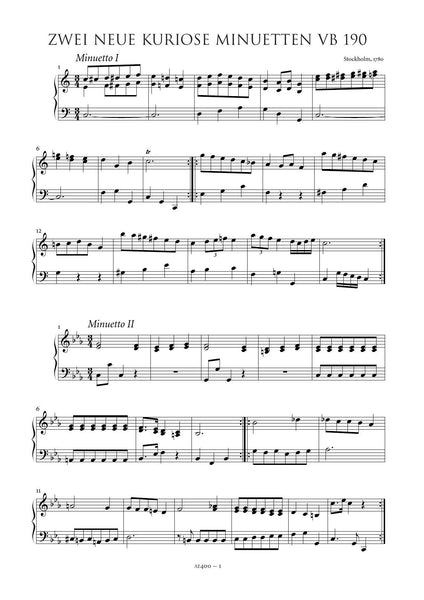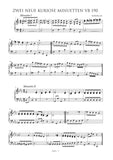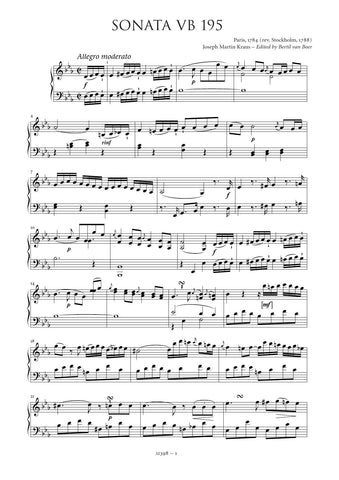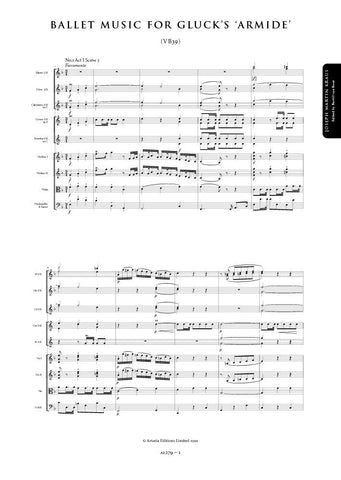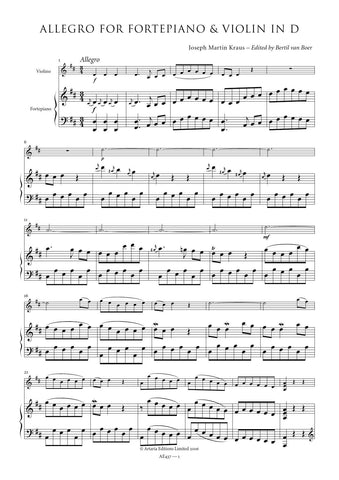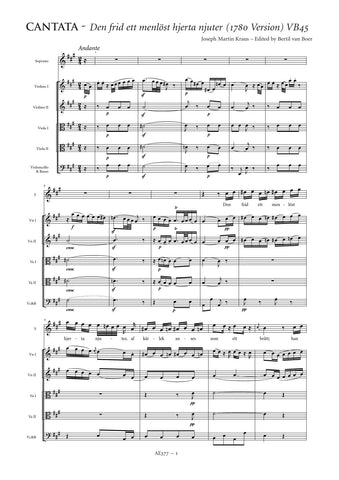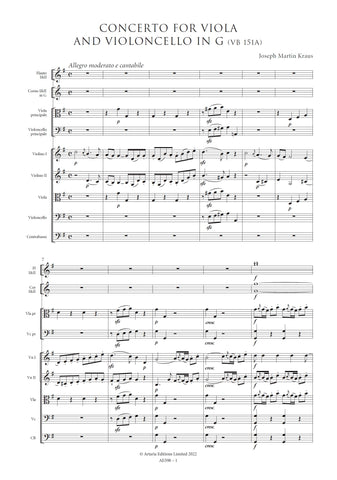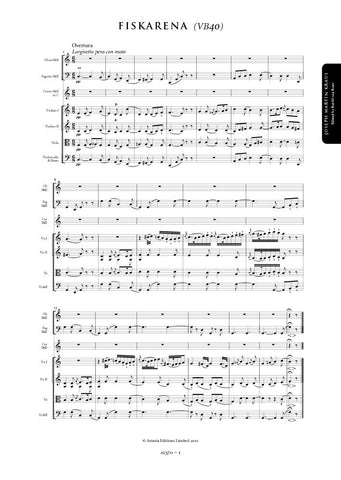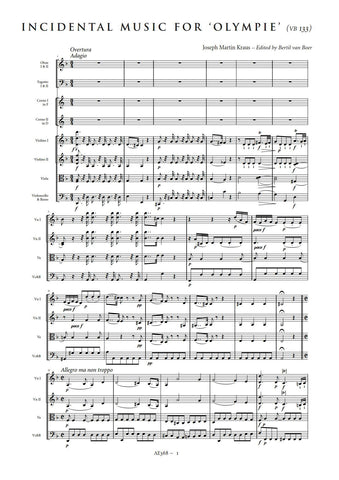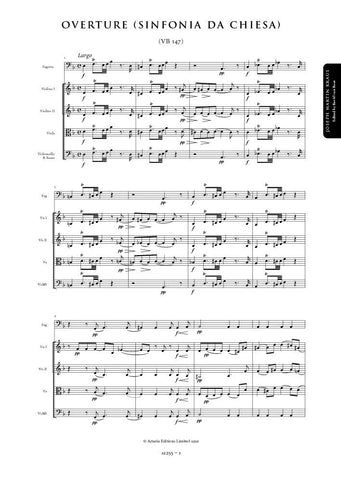Details
|
The sources for the keyboard works stem mainly from the (divided) collections of Kraus's first biographer, Fredrik Silverstolpe. The Rondo and two sets of variations, along with a short sixteen bar Larghetto that may have been intended as the theme for a third set of variations, are all found in Silverstolpe's authentic copy entitled Tre Variations-Stycken fr Fortepiano [Three (sic) variations pieces for fortepiano] in the Silverstolpe collection at the University of Uppsala Library. In addition, the second of these works, twelve variations on a Scherzo theme, was published after Kraus's death, first in the journal Musikaliskt Tidsfjrdrif [Musical Pastimes] and in England under the authorship of both Ignaz Pleyel and Joseph Haydn with the original 3/8 time expanded to 3/4 and a very amateurish violin part added. The two joke minuets and the organ preludes were discovered in Silverstolpe's private musical archive at the family estate at Ns herrgrd, R, Uppland, Sweden by carl-Gabriel Stellan Mrner and the present author. The former is on a single leaf of manuscript with Silverstolpe's annotations, while the latter forms part of a set of eleven chorale-preludes, the remainder of which are by the popular German organist Johann Christian Rinck (1770-1846). This source is in the hand of Kraus's pupil and friend, Johan Wikmanson (1753-1800), and probably represents a workaday set composed for some ordinary Sunday service at the parish church where Wikmanson was organist.
The pair of minuets is entitled Zwei neue kuriose Minuetten (VB 190), which was evidently written as a pedagogical jest rather than as a serious composition. According to the sole source, it was written in 1780 as a musical joke and sent to the Bach biographer Johann Nikolaus Forkel, with whom Kraus had debated the merits of early music when he was at Gttingen in 1777-1778. The works are satirical pokes at Johann Sebastian Bach. The first minuet is a parody of a work from Anna Magdalena's Notebook, replete with odd chromaticism and strange rhythmic twists. The second minuet is a musical joke that recalls the work of an incompetent, or stylistically inept composer (no doubt a direct allusion to Forkel). In c minor, it veers suddenly to the dominant of the relative major with a series of odd repeated quavers. Realizing that he has modulated to the wrong key, the composer uses an odd sequence of thirds to wrench the tonality back to the correct place. The misplaced octaves and rhythmic incongruity of the ending are calculated both to annoy the recipient and give the audience a good laugh.
The Rondo in F major (VB 191) is perhaps the earliest surviving work for fortepiano by Kraus, having been composed in Stockholm during the period 1778-1780; it was sold in manuscript form by the Viennese firm of Johann Traeg beginning in 1782, and its stylistic similarity with the works of C.P.E. Bach show that composer's influence in the ornamentations, fluctuations of intensity and dynamics, and free use of thematic material in each of the four episodes or variations. The main theme is gentle and lyrical, allowing the tension-building contrasts to be resolved and resulting in a smooth flow from one section to the next. Of particular interest is the fact that Kraus refrains from exact repetition of the main Rondo theme; rather he uses it in a chain of variations that adds interest and a degree of difficulty.
The Scherzo con Variazione in C major (VB 193) is an unusual set of twelve variations based upon a theme of utmost simplicity, a series of horn fifths and resolutions that later became used as a well-known hymn. It is almost certain that this set was written in London in 1785, while Kraus was visiting the English capital for the Handel Centenary Festival. Later published by Åhlstrm, it became a favourite work of late 18th-century Swedish pianists. Additionally, as noted above, it was published in London with an amateurishly added violin accompaniment under the names of both Pleyel and Joseph Haydn. Throughout the work the composer explores the almost infinite variety of variation technique, providing opportunity for both virtuosity and musical interest. Of particular note is the fifth variation, where the music veers drunkenly from one strange minor key to the next, the tenth, which is based upon a Scotch snap bass line motive, and the final which contains a conclusive Kehraus, a signal that the work is over and all should go home.
The Svensk Dans (VB 192) was composed sometime during the first decade of Kraus's time in Sweden, probably closer to 1788 than 1778.Written in C major, it comprises a series of three short variations set to a perpetual motion dance from Vingker.Why he wrote this work is unknown, since the composer normally had no real interest in such nationalistic tunes. It may well be, however, that he sought to compete with his rival, Abb Georg Vogler, who he suspected of trying to usurp his position at the Swedish court. Vogler was well known for his transcriptions of "folk" tunes (including, bizarrely enough, some he stated he had obtained as far away as Greenland and China), and this short set of variations may simply have been a means of demonstrating that Kraus too was capable of writing such things.
The extremely brief Larghetto (VB 194) was probably written in Stockholm about 1787-1788.While there is no information on why Kraus wrote this lilting gavotte, it most likely represents the theme intended for a further set of variations, which he did not complete. Kraus biographer Karl F. Schreiber described it as a "Lied ohne Worte", which, although applicable to its lyrical melody, is certainly not what the composer intended and, moreover, is anachronistic.
The Five Chorale Preludes for Organ (VB 197) are part of a set of eleven that are clearly intended to be performed in an ordinary service and therefore probably represent an artificial grouping rather than a deliberate collaboration. The source indicates that these were passed on to Silverstolpe by Wikmanson after the latter's death in 1800. Since Rinck's preludes began to appear in Sweden about 1790-1791, it may well be that these simple works date from the last years of Kraus's life, and were considered by him (and subsequently Silverstolpe) to be merely favours for a friend rather than some major opus. These are, however, his only surviving works for organ, and it is interesting to note that the first piece is based upon a theme taken from (or foreshadowing) an aria from Kraus's well-known Funeral Cantata for Gustav III from 1792. It is unknown whether these are related to each other in any way or if they are excerpted from some larger group written by the composer. There is no pedal line, but it is clear that some of the lower notes were to be played on the pedal keyboard. No information on registration is provided apart from the general comment to use "svaga stammer", the soft voicings.
As in much of Kraus's music, the markings and articulations are painstakingly deliberate. The present edition has modernized the scores, clarified a very few of the markings, and corrected the rare note, when such can be determined to be an obvious mistake by the copyist.
Bertil van Boer
|




